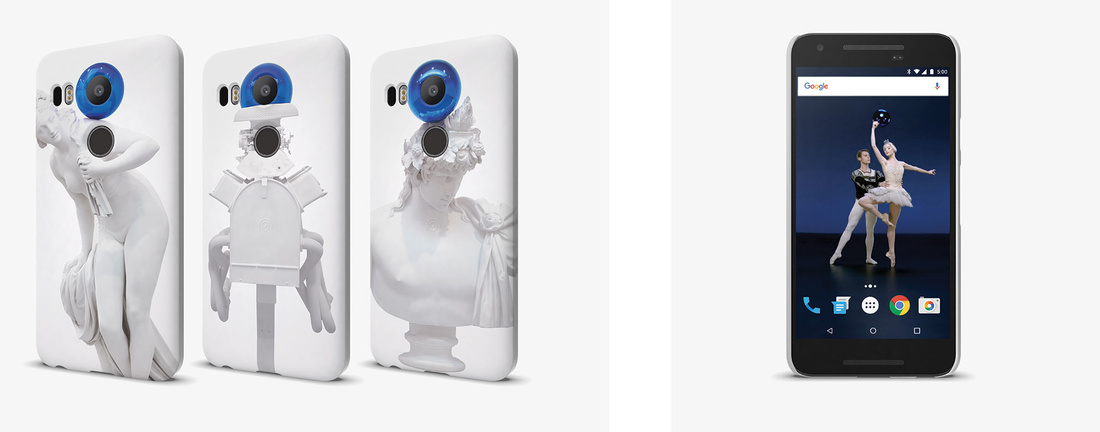Wednesday 13th July 2016GooglexKoons Collaboration Underwhelms
At the outset, it's probably important to say that I've never been a particular fan of the work of Jeff Koons. It's hard to pin down exactly what it is that bothers me about him specifically, but there's something there, a thread winding its way through all my perceptions of his work and poisoning them. Hopefully that isn't (just) what's happening here, but I'll let you be the judge of that.
Koons' latest piece is a distinct departure from his previous works, both in terms of medium and of content. It features video, dance and … a product. A cheap product. A cheap phone case. Right now, you're asking yourself…. 'What?'
Google wanted to unveil a new product, the 'Live' phone case for their latest flagship smartphone, known as the Nexus. It's not a bad idea, in and of itself, since they can be completely customised to whatever you desire for a grand total of $40 USD, which is pretty decent for a custom phone case. The case comes paired with matching live video wallpaper that you can only view on the phone when you're using it with that particular live case.
Say, for example, you had a video of your baby's first birthday or a kitten playing with a puppy, you could make a case that was adorned with a still frame from the video and then the video itself would play in the background when the case was attached. Not particularly innovative, perhaps, but it could be an interesting way of passing on videos. The part where it all breaks down is why they chose to launch it with artworks by Koons.
Some of the selections shown in the post image above are fairly appealing, but in general, the piece sort of falls flat. You could argue that this is because it was Koons' first experimentation with video, but that hardly seems fair considering that this is really a Google product launch and Koons is more of a prop than an integral part. It consists of a re-imagination of the ballet Swan Lake, performed with a classic Koons reflective object - in this case, a giant sphere like a medicine ball - which sort of destroys the entire point of Swan Lake.
Ah well, perhaps nobody would even have noticed that Koons was involved if it was just a typical product launch.
Posted on July 13th 2016 on 09:08pm
0 Comments
Wednesday 30th April 2014Artist Spotlight: Jeff Koons

In this new series of posts, we're going to take a look at some of the dichotomies of the art world: the most influential artists and the rising stars, the well-known and the unknown, the sought-after and the reviled. Sometimes, as in the case of this week's post, it will be up to you to decide which categories the artist falls into. Jeff Koons is a very polarizing force in the contemporary art community for a number of reasons, but his staying power and his influence cannot be denied. As we discussed in a previous post, Koons currently holds the world record for highest auction price attained for a work by a living artist, when 'Balloon Dog (Orange)' sold recently for over $37 million USD.
Koons tends to work in a series modality, creating a number of works in a specific series as he explores various themes related to the series. The Balloon Dog sculptures, for instance, belong to a series he calls 'Celebration'. It's one of his most well-known series, largely because of the headline grabbing sums of money attached to the sale of the pieces. They feature a variety of large sculptures executed in colourized, highly reflective stainless steel.
The really interesting thing about Koons' work, though, at least in this writer's opinion, is the way he deals with criticism and with meaning. He claims that his works have no hidden meanings, that there is no sly satirical laughing up his sleeve at the modern art establishment, and yet that's exactly how many critics seem to view his work. This is probably at least partially informed by the way in which many of his pieces are constructed. Perhaps taking a leaf out of Andy Warhol's Factory book, Koons developed a 'colour-by-numbers' system that allowed his legions of assistants (over 100 at the latest count) to produce his works while staying true to his original vision, as though they were created "by a single hand".
"I think art takes you outside yourself, takes you past yourself. I believe that my journey has really been to remove my own anxiety. That's the key. The more anxiety you can remove, the more free you are to make that gesture, whatever the gesture is. The dialogue is first with the artist, but then it goes outward, and is shared with other people. And if the anxiety is removed everything is so close, everything is available, and it's just this little bit of confidence, or trust, that people have to delve into."
An interesting idea, but at least at the moment, it seems like he's removed so much anxiety by not actually being involved in the production process of any of his work. In this critic's opinion, it's something of a cop-out.
Posted on April 30th 2014 on 10:35pm
0 Comments
 At the outset, it's probably important to say that I've never been a particular fan of the work of Jeff Koons. It's hard to pin down exactly what it is that bothers me about him specifically, but there's something there, a thread winding its way through all my perceptions of his work and poisoning them. Hopefully that isn't (just) what's happening here, but I'll let you be the judge of that.
At the outset, it's probably important to say that I've never been a particular fan of the work of Jeff Koons. It's hard to pin down exactly what it is that bothers me about him specifically, but there's something there, a thread winding its way through all my perceptions of his work and poisoning them. Hopefully that isn't (just) what's happening here, but I'll let you be the judge of that. In this new series of posts, we're going to take a look at some of the dichotomies of the art world: the most influential artists and the rising stars, the well-known and the unknown, the sought-after and the reviled. Sometimes, as in the case of this week's post, it will be up to you to decide which categories the artist falls into. Jeff Koons is a very polarizing force in the contemporary art community for a number of reasons, but his staying power and his influence cannot be denied. As we discussed in a previous post, Koons currently holds the world record for highest auction price attained for a work by a living artist, when 'Balloon Dog (Orange)' sold recently for over $37 million USD.
In this new series of posts, we're going to take a look at some of the dichotomies of the art world: the most influential artists and the rising stars, the well-known and the unknown, the sought-after and the reviled. Sometimes, as in the case of this week's post, it will be up to you to decide which categories the artist falls into. Jeff Koons is a very polarizing force in the contemporary art community for a number of reasons, but his staying power and his influence cannot be denied. As we discussed in a previous post, Koons currently holds the world record for highest auction price attained for a work by a living artist, when 'Balloon Dog (Orange)' sold recently for over $37 million USD.



